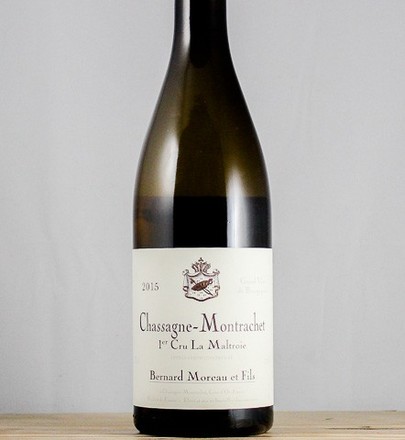
"Neal Martin 91-93/100
The 2018 Chassagne-Montrachet La Maltroye 1er Cru has a slightly reserved bouquet that is less expressive than its sibling Chassagnes at the moment; fleeting touches of citrus lemon and smoke emerge with aeration. The palate is well balanced with a very saline opening that counters the richness on the midpalate. There is weight and power to this Maltroye, yet the acidity offsets that and leaves it feeling perfectly balanced, with a very long, spicy tail on the finish. Excellent. Vinous.com January 2020"
The Domaine can be traced back to 1809 with the construction of the first family cellar by Auguste Moreau, in the 1930’s Marcel Moreau purchased the majority of the vineyards that the family owns to this day, and in the early 1960’s at a very young age Bernard Moreau had to take over the cellars and vineyards and in 1977 the estate was renamed Domaine Bernard Moreau. In turn his sons Alex and Benoît joined the Domaine after having worked in New Zealand, Australia and South Africa, their first vintage in 1995 and they took over the vineyards and winemaking in 1999. Alex and Benoit share the running of the estate with Benoit focused on the vineyards and Alex in the cellar.
Readers will know the high esteem in which I hold Domaine Bernard Moreau and winemaker Alexandre Moreau. You want the best Chassagne-Montrachet? This is where you call first. I have absolutely no reason to alter that view with respect to the 2018s.
'We started picking on 30 August, the same date as 2017 but the profile of the vintage is different' Moreau told me surrounded by stainless steel vats. 'This was because of the size of the crop and the heat. I like to have freshness and not too much alcohol, so I was anxious about the picking date. So I controlled the maturity, constantly tasting in the vineyard and soon realised that the sugar level can rise quicker than the phenolic maturity. I have now started the harvest in August in 2015, 2017 and 2018. I couldn’t understand why if August was so warm, the increase in sugar level was actually quite slow. I knew it was generous, but I did not know it would be so generous in older vineyards - something that I have never seen. For example, I haven’t made nine barrels of Chassagne Chenevottes since I began, then again, yields are only just above 50hl/ha for the Premier Crus. Maybe people are expecting something like 2003, but the 2018s are not heavy at all. For the Village and Premier Crus the alcohol is between 13.0° and 13.5°. As usual we practice natural fermentations, no racking and so forth - the only difference in 2018 is that it was a super-long alcoholic fermentation. Many barrels were fermenting until July - and I don’t mind that - I like to play this game as you have activity in the barrel with the fine lees in suspension and natural CO2 that protects your wine. The pH is around 3.19, which gives them a lot of freshness. It is not a vintage for early bottling and so most of the Premier Crus will be bottled next Spring.'